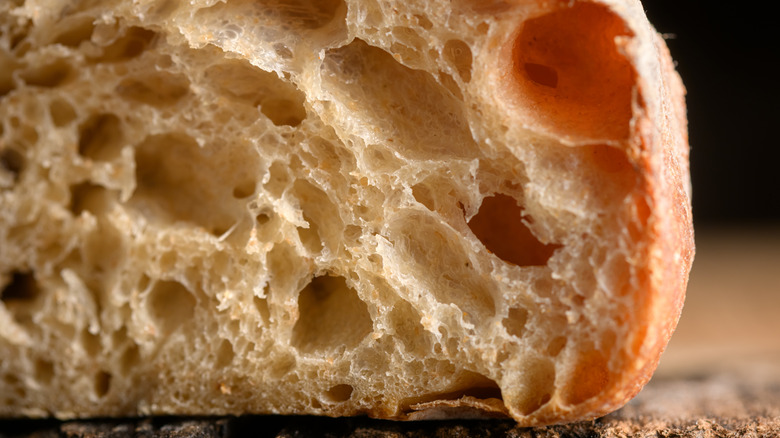High-Hydration Bread Vs Traditional Bread: What's The Actual Difference?
My fiancé's father bakes the most incredible bread. It's soft and supple with an open crumb, lightly chewy texture, and just-crisp-enough crust. But whenever I ask him for the recipe, he gets coy. "Oh, flour, water, yeast, salt," he'll say. It's infuriating. I could've guessed that! The ratios make all the difference — and he keeps his under wraps. Hydration, or the ratio of flour and water in bread, is one of the most important factors for bread-baking success. Understanding hydration can help you craft your own bread recipes — and help you understand how a dough will behave before you even start mixing the ingredients.
What is considered high-hydration bread? The Takeout talked to Erik Fabian to find out. Fabian is the founder of Sourhouse, a company that crafts chic tools for sourdough bakers. "I would say most often I hear over 75% hydration being considered high hydration," Fabian said. "Any type of bread with enough water is considered high hydration." A dough that combines 75 grams of flour and 100 grams of water would meet that 75% hydration mark. While hydration isn't the be-all and end-all of breadbaking, knowing when to use it to your advantage can make you a better baker.
What is high-hydration bread like?
There is one thing I can determine about my future father-in-law's bread: He probably uses a high- or medium-high-hydration dough. That's why his bread has an open crumb, the technical term for those big, beautiful bubbles you'll see inside artisan bread. "More water tends to open up the crumb ... to a point," Erik Fabian said. "Ciabatta is an example of a style of bread typically made with higher hydration."
High-hydration dough is time-consuming and difficult to work with — one reason why bakers like to brag about it. "Adding more water will speed up the fermentation a bit and make building the gluten structure and handling the dough a bit trickier," Fabian said. "When doing the final shaping, for example, higher hydration doughs can feel stickier and be harder to tightly shape." That doesn't mean high-hydration bread is utterly inaccessible to amateurs: An ultra-high 100% hydration ratio is the key to making perfect no-knead bread. Otherwise, you'll want to knead high-hydration dough longer to avoid killing your bread before it rises.
Hydration affects the shape of the final loaf in other ways, too. High-hydration bread is often flatter, even with plenty of time to rise. "Wetter dough can also spread more after being shaped, leading to squatter bread if not enough effort is made to build the gluten structure," Fabian said. Since a strong gluten structure is especially important in high-hydration bread, you'll want to use high-protein flour. The proteins combine with water to make that gooey gluten structure.
What is low-hydration bread like?
Low-hydration (or traditional) bread is easier to work with, so it's often recommended for beginners. But low-hydration bread can be dense and, unsurprisingly, dry. It tends to spoil faster, too. The right amount of hydration will depend on the kind of bread you're baking, the flour you're using, and the other ingredients in the bread. Look for low-hydration recipes if you're planning to bake sandwich bread. Consider the type of flour you're using, too. Whole wheat flour absorbs more water than bread flour or all-purpose flour, so you'll need to up the hydration accordingly. But even high-hydration whole wheat bread will be relatively dense, since whole wheat can't support the same strong gluten structure that you'd get from regular bread flour. Try adding vital wheat gluten to your whole wheat bread if you want a lighter, fluffier structure.
"Typically, enriched breads use lower hydrations," Erik Fabian explained. Enriched breads include ingredients that make them richer: eggs, milk, butter, or oil. Brioche and challah are two popular examples. For lean, or unenriched dough, hydration usually bottoms out at around 50%. Since ingredients like eggs and butter contain water, enriched dough may have just 10% hydration. While hydration isn't the only factor that can affect your bread, it gives you the freedom to experiment with recipes — without relying solely on trial and error. Personally, I haven't cracked my future father-in-law's code yet, but he'd better watch out. I'll figure it out someday.


